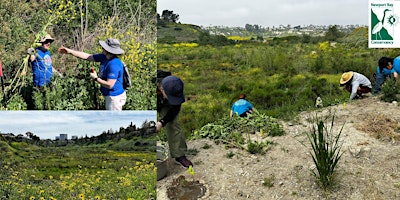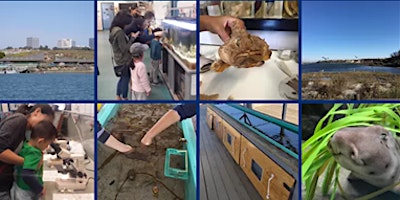This monthly reading group is an opportunity to learn about the ways diverse groups experience the natural world, engage in environmental efforts, or have been prevented from engaging in these activities through racism, cultural bias, and economic disadvantage, both historically and in the present moment.
Currently reading: Aldo Leopold, Sand County Almanac (1949): June and July nature notes; “Thinking Like a Mountain”; “Conservation Esthetic”. Next meeting date: Wed, Aug 2nd
We currently meet monthly on the first Wednesday at 5:30pm via Zoom. Interested in joining our discussion? Contact Hilary at hilary.cunningham@newportbay.org for more information.
Past Readings
May 2023
- Aldo Leopold, Sand County Almanac (1949), selections including “Wilderness”
Apr 2023
- Aldo Leopold, Sand County Almanac (1949), selections including “The Land Ethic”
Mar 2023
-
We reviewed a website: Azul — a grassroots organization working with Latino/as to conserve marine resources
-
And a related opinion piece: Latine communities have solutions to ocean and climate challenges
Feb 2023
- Overheated The Documentary. A film for a critically overheated planet. Produced by Safe, Soliman, and Support + Food. Features notable music and fashion figures from the West along with climate activists and Indigenous peoples from other regions (Amazon, Africa, Arctic). [no date] (video – 37 mins)
- Stand Up/ Stand N Rock #NoDAPL – youtube video, 2016 (video – 5 mins)
Dec 2022
- Elizabeth Kolbert, “A Vast Experiment” New Yorker Nov 28, 2022 (pp. 33-47) – an overview of the climate crisis from A to Z
- Jaclyn Diaz, “3 tribes dealing with the toll of climate change get $75 million to relocate” NPR Dec. 1, 2022.
- Kathleen Ronayne, “Drying California late to get $250M in US drought funding.” AP News Nov. 28, 2022.
Jun-Oct 2022
- Cynthia Kaufman, The Sea is Rising and So Are We. A Climate Justice Handbook. (PM Books, 2021).
- Equity Leaders Speaker Series 2022: Katherine Toy, Deputy Secretary for Access, California Natural Resources Agency. (video – 57 mins)
- Christiana Figueres (guiding force in the 2015 Paris Agreement), “The case for stubborn optimism on climate.” TED Talk. (video – 8 mins)
- Matthew Taylor and Jonathan Watts, “Revealed: the 20 firms behind a third of all carbon emissions.” The Guardian Oct. 2, 2019.
May 2022
- From High Country News – Pauly Denetclaw, “Colorado River, stolen by law” (March 1, 2022)
Apr 2022
- Exploring the history of environmental justice to support anti-racism (9 min.) – Learn about the neighborhood of free African American property owners in New York City, Seneca Village, that was displaced in 1857 to make room for Central Park.
- A cluster on land back issues in the Black Hills, SD:
- What the Indians think of the Black Hills (reading matter)
- The importance of the Black Hills (video – 4 mins)
- The case for returning land to original owners (video – 8 mins)
- Why the Black Hills were given back to the Lakota and then taken away, again. (video – 6.5 mins)
Mar 2022
- J. Drew Lanham – article in Audubon Magazine about the race, racism, and the organization’s founder
- Podcast with Lanham: The Possibilists — Episode 8
- NPR – A California Redwood Forest Has Officially Been Returned to a Group of Native Tribes
- YouTube Video on forest area
Feb 2022
- Drew Lanham, “A Convergent Imagining,”
Lanham asks, What if Dr. Martin Luther King Jr. and Rachel Carson had met? Imagining an exchange in the year 1964, as the civil rights and environmental movements were forging parallel and increasingly urgent paths into American culture. A timely selection, given the January celebration of MLK. If you want to deepen the experience, take a(nother) look at his “A Letter from a Birmingham Jail”? Either the letter itself or in video format.
Jan 2022
- Podcast – How to Save the Planet: The Tribe that’s Moving Earth (and Water) to Solve the Climate Crisis
It features Yurok initiatives to undo some of the damage to their ancestral lands in Northern California using both native and western methods
Dec 2021
- Podcast: How to Save a Planet with Alex Blumberg: Your carbon footprint. Does your carbon footprint even matter? In this episode, we look at individual actions vs. systemic change.
- M. R. O’Connor, “What It’s Like to Fight a Megafire,” New Yorker (NOV. 8, 2021). A journalist trains as a fire-fighter and interviews fire-fighters who have been involved in some of California’s recent megafires. The article exposes the mental health risks and economic exploitation of a group of adventure-seeking young men (and some women) who throw themselves into the profession without support from the industry.
Mar-Nov 2021
- All We Can Save: Truth, Courage, and Solutions for the Climate Crisis edited by Ayana Elizabeth Johnson and Katharine K. Wilkinson
Feb 2021
- Angelou Ezeilo, Engage, Connect, Protect: Empowering Diverse Youth as Environmental Leaders, chapters 1 and 2
- “Using Technology as an Entry Tool to Nature“
- Casey Berkovitz, “Environmental Racism Has Left Black Communities Especially Vulnerable to COVID-19“
Dec 2020 — youth, technology, nature
- “Using Technology as an Entry Tool to Nature”
- Deborah J. Chavez, “Youth Day in Los Angeles: Evaluating the Role of Technology in Children’s Nature Activities” Children, Youth and Environments (vol. 19, No. 1, 2009) pp. 102-124 (23 pages)
Nov 2020 — basic/background readings in race/diversity and engaging minority youth in nature
- “Prologue” (pp. 1-11) to Ibram X. Kendi’s Stamped from the Beginning. The Definitive History of Racist Ideas in America (New York: Nation Books, 2016).
- Breaking Green Ceilings podcast, Episode 28: “How to Diversify Environmental Organizations”
- “Youth Outdoors and Nature” from San Francisco State University, 2012.
Oct 2020 — Latinx people and nature/environmentalism plus some basic anti-racist material
Readings
- Peggy McIntosh, “White Privilege: Unpacking the Invisible Knapsack.” Peace and Freedom (July/August 1989) – 3 pp.
- David Flores and José J. Sánchez, “The Changing Dynamic of Latinx Outdoor Recreation on National and State Public Lands.” Journal and Park and Recreation Administration (2020) – 18 pp.
- Nathan Taxel, “Words Matter.” Legacy. The Magazine of the National Association for Interpretation. September/October 2020, 7-9.
- José González, “Park closures have unequal costs.” High Country News 16 April 2020. – 3 pp. (reprinted in Mother Jones)
Podcasts
- Latino Outdoors: Jose Gonzalez on Representation in the Outdoors, 31 January 2020. 1 hour (interview starts at about 7 min. in)
- Black Lives Matter and the Climate by How to Save a Planet (24 Sept. 2020) (46 min.)
Other resources
These three sites come from a large site called Children and Nature Network – It has many short essays and lots of resources.
- Thriving together: A springboard for Equitable Recovery & Resilience in Communities Across America (pdf 339 pp.)
- Anti-racism in the Outdoors: Resources related to inclusion, diversity, equity & access
- Nature & Privilege
https://latinooutdoors.org/about-us/
Sept 2020
Readings
- Christopher J. Schell, et al. “The ecological and evolutionary consequences of systemic racism in urban environments.” Science 13 Aug 2020, 1-19. (pdf attached). This article reviews studies of urban ecology, arguing that “urban ecology and evolution researchers must consider how systems of racial oppression affect the environmental factors driving biological change in cities.”
- The Green Report from July 2020: The Nature Gap: Confronting Racial and Economic Disparities in the Destruction and Protection of Nature in America. I really appreciated the way this study focuses on the occurrence and consequences of “nature deprivation.”
- An op-ed piece from the LA Times – Matthew Fleischer, “Want to tear down insidious monuments to racism and segregation? Bulldoze L.A. freeways.” 24 June 2020.
- Two excerpts from a memoir by J. Drew Lanham: The Home Place: Memoirs of a Colored Man’s Love Affair with Nature. Lanham grew up in a middle-class black family in Edgefield County, South Carolina. His parents taught school but also farmed a 200-acre Forest Service inholding. Today he is a professor of Wildlife Ecology at Clemson University. We read two excerpts: “Me: An Introduction” and “Birding While Black.” (13 pp.)
Podcasts
- Stoop podcast, episode 19: Summer Series: Buffalo Soldiers (interview with a Black Yosemite National Park ranger who tells the stories of the Buffalo Soldiers to park guests) – 8 min.
- A podcast originating in the UK, Black Nature Narratives, but featuring people from the US. We listened to an episode on the theme of African Americans in nature: Episode 5, Eboni Preston, Director of Programmes for the Greening Youth Foundation, a national non-profit in the US. This Atlanta based organization has partnered with the National Park Service to increase opportunities for African American young people to enter environmental careers. (19 min.)
Aug 2020
listening:
- Stuff You Missed in History Podcast: Occupation of Alcatraz, Part 1 & Part 2 (gives in-depth context from colonization to the occupation in 1969) – 44 min. each
viewing:
- “A Conversation with Native Americans on Race” | Op-Docs. New York Times, 15 Apr 2018.
- A map of the villages in LA County
reading:
- Lightfoot and Parrish, “Why California Indians Matter” from California Indians and Their Environment: An Introduction. U of California P, 2009. (12 pp.)
- Gilio-Whitacker, Dina. As Long as Grass Grows. The Indigenous Fight for Environmental Justice, from Colonization to Standing Rock. (Beacon P, 2910). ch. 7, “Sacred Sites and Environmental Justice” (16 pp.)
Jul 2020
(1) Carolyn Merchant’s “Shades of Darkness: Race and Environmental History” (Environmental History 8.3, July 2003: 380-94) is a review of scholarship in the field as of 2003.
(2, 3) Dorceta E. Taylor, in Toxic Communities: Environmental Racism, Industrial Pollution, and Residential Mobility (NYU Press, 2014), draws on case studies in zoning law, government regulation, and urban renewal to investigate environmental transgressions and racial discrimination. We read two chapters from this book:
- Chapter 1, “Toxic Exposure: Landmark Cases in the South and the Rise of Environmental Justice Activism,” and
- Chapter 5, “Enforcing Environmental Protections: The Legal, Regulatory, and Administrative Contexts.”
(4) Brinda Sarathy, “An Intersectional Reappraisal of the Environmental-Justice Movement,” in The Nature of Hope. Grassroots Organizing, Environmental Justice, and Political Change (ed. Char Miller and Jeff Crane, UP of Colorado, 2018), argues for broadening EJ inquiries. She mentions a California case at the end of the article.









